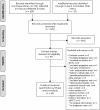The effectiveness of reproductive surgery in the treatment of female infertility: facts, views and vision
- PMID: 25009712
- PMCID: PMC4086009
The effectiveness of reproductive surgery in the treatment of female infertility: facts, views and vision
Abstract
Background: The role of reproductive surgery is declining due to the widespread availability of assisted reproductive technology, but an evidence-based fundament for this decline is lacking. We therefore performed a systematic review of the literature.
Methods: We searched MEDLINE, EMBASE and the Cochrane Library for randomised trials evaluating laparoscopic or hysteroscopic interventions in subfertile women, studying pregnancy or live birth rates. We present an overview of the results and quality of the detected studies.
Results: The methodological quality of the 63 detected studies was mediocre. The laparoscopic treatment of minimal/ mild endometriosis might increase the pregnancy rate but the two major studies report conflicting results. Excision of the endometriotic cyst wall increases the spontaneous conception rate (RR 2.8, 95% CI 1.4-5.5). Laparoscopic ovarian drilling results at least in equal pregnancy rates as gonadotropin treatment (RR 1.0, 95% CI 0.83-1.2) but decreases the multiple pregnancy rate (RR 0.16, 95% CI 0.04-0.58). Laparoscopic tubal surgery for hydrosalpinx prior to IVF increases the pregnancy rate (RR 1.9, 95% CI 1.4-2.7). Removal of polyps prior to IUI increases the pregnancy rate (RR 2.2, 95% CI 1.6-3.1). Myomectomy for submucosal fibroids results in higher pregnancy rates (RR 2.2, 95% CI 1.6-2.9). The removal of intramural/ subserosal fibroids shows a beneficial trend, albeit not statistically significant (RR 1.2, 95% CI 0.75-1.9). Hysteroscopy in patients with recurrent IVF failure increases the pregnancy rates even in the absence of pathology (RR 1.6, 95% CI 1.3-1.9).
Conclusions: Although the limited evidence indicates a positive role for some surgical reproductive interventions, we should be very cautious in providing guidelines for clinical practice in reproductive surgery since more research is needed.
Keywords: Laparoscopy; effectiveness; hysteroscopy; live birth rate; pregnancy rate; reproductive surgery.
Figures









Similar articles
-
Hysteroscopy for treating subfertility associated with suspected major uterine cavity abnormalities.Cochrane Database Syst Rev. 2018 Dec 5;12(12):CD009461. doi: 10.1002/14651858.CD009461.pub4. Cochrane Database Syst Rev. 2018. PMID: 30521679 Free PMC article.
-
In vitro fertilization and multiple pregnancies: an evidence-based analysis.Ont Health Technol Assess Ser. 2006;6(18):1-63. Epub 2006 Oct 1. Ont Health Technol Assess Ser. 2006. PMID: 23074488 Free PMC article.
-
Surgical treatment for tubal disease in women due to undergo in vitro fertilisation.Cochrane Database Syst Rev. 2020 Oct 22;10(10):CD002125. doi: 10.1002/14651858.CD002125.pub4. Cochrane Database Syst Rev. 2020. PMID: 33091963 Free PMC article.
-
Surgical treatment of fibroids for subfertility.Cochrane Database Syst Rev. 2020 Jan 29;1(1):CD003857. doi: 10.1002/14651858.CD003857.pub4. Cochrane Database Syst Rev. 2020. PMID: 31995657 Free PMC article.
-
The management of uterine fibroids in women with otherwise unexplained infertility.J Obstet Gynaecol Can. 2015 Mar;37(3):277-285. doi: 10.1016/S1701-2163(15)30318-2. J Obstet Gynaecol Can. 2015. PMID: 26001875
Cited by
-
Impact of cancer treatment on risk of infertility and diminished ovarian reserve in women with polycystic ovary syndrome.Fertil Steril. 2018 Mar;109(3):516-525.e1. doi: 10.1016/j.fertnstert.2017.11.016. Epub 2018 Feb 7. Fertil Steril. 2018. PMID: 29428311 Free PMC article.
-
Uterine fibroid management: from the present to the future.Hum Reprod Update. 2016 Nov;22(6):665-686. doi: 10.1093/humupd/dmw023. Epub 2016 Jul 27. Hum Reprod Update. 2016. PMID: 27466209 Free PMC article. Review.
-
Hospitalization before and after delivery in fertile, subfertile, and ART-treated women.J Assist Reprod Genet. 2019 Oct;36(10):1989-1997. doi: 10.1007/s10815-019-01562-2. Epub 2019 Aug 14. J Assist Reprod Genet. 2019. PMID: 31414316 Free PMC article.
-
Progress in evidence based reproductive surgery.Facts Views Vis Obgyn. 2011;3(4):238-44. Facts Views Vis Obgyn. 2011. PMID: 24753872 Free PMC article.
-
Inpatient hospitalizations in women with and without assisted reproductive technology live birth.J Assist Reprod Genet. 2017 Aug;34(8):1043-1049. doi: 10.1007/s10815-017-0961-z. Epub 2017 Jun 1. J Assist Reprod Genet. 2017. PMID: 28573528 Free PMC article.
References
-
- Aakvaag A. Hormonal response to electrocautery of the ovary in patients with polycystic ovarian disease. Br J Obstet Gynaecol. 1985;92:1258–1264. - PubMed
-
- Acunzo G, Guida M, Pellicano M, et al. Effectiveness of auto-cross linked hyaluronic acid gel in the prevention of intra-uterine adhesions after hysteroscopic adhesiolysis: a prospective, randomised, controlled study. Hum Reprod. 2003;18:1918–1921. - PubMed
-
- Adamson GD, Pasta DJ. Surgical treatment of endometriosis- associated infertility: meta-analysis compared with survival analysis. Am J Obstet Gynecol. 1994;171:1488–1505. - PubMed
-
- Adhesion Study Group , Malinak R, Cleary R. Reduction of postoperative pelvic adhesions with intraperitoneal 32% dextran 70: a prospective, randomised clinical trial. Fertil Steril. 1983;40:612–619. - PubMed
-
- Ahmad G, Watson A, Vanderkerckhove P, et al. Techniques for pelvic surgery in subfertility. Cochrane Database Syst Rev. 2009;(issue 1: CD 000221) - PubMed
Publication types
LinkOut - more resources
Full Text Sources
Molecular Biology Databases
